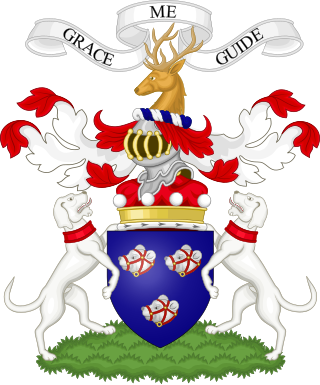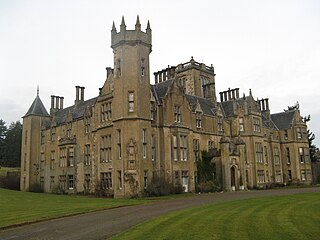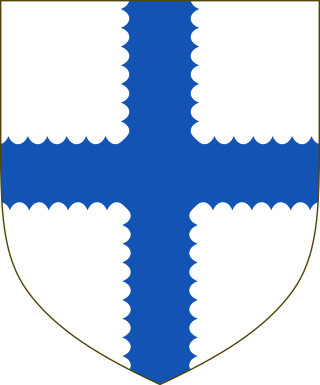Related Research Articles

Banffshire is a historic county, registration county and lieutenancy area of Scotland. The county town is Banff, although the largest settlement is Buckie to the west. It borders the Moray Firth to the north, Morayshire and Inverness-shire to the west, and Aberdeenshire to the east and south.

Earl of Airlie is a title of the peerage in Scotland created on 2 April 1639 for James Ogilvy, 7th Lord Ogilvy of Airlie, along with the title "Lord Ogilvy of Alith and Lintrathen". The title "Lord Ogilvy of Airlie" was created on 28 April 1491.

Lord Balfour of Burleigh, in the County of Kinross, is a title in the Peerage of Scotland. It was created in 1607 for Sir Michael Balfour.

James Ogilvy, 4th Earl of Findlater and 1st Earl of Seafield, was a Scottish politician, prominent during the reign of Queen Anne. He was created Earl of Seafield in 1701 and was an active supporter of the 1707 Act of Union.
George Gordon, 2nd Earl of Huntly was a Scottish nobleman and Chancellor of Scotland from 1498 to 1501.

Sir Robert Lauder of Beilmouth, Knt., was an armiger, lawyer and Clerk of Exchequer in Scotland. In 1683 he was made a Justice of the Peace for Haddingtonshire. In 1685, under the title Robert Lauder of Belhaven, he was a member of the Scottish parliament for Haddington, and in 1704 as Sir Robert Lauder of Beilmouth. He was also Commissioner of Supply for Haddington in 1689 and 1690.

George Ogilvy, 2nd Lord Banff was member of the old Scottish Parliament, a feudal baron, and a Cavalier.

George Keith, 5th Earl Marischal (c. 1553–1623) was a Scottish nobleman and Earl Marischal. He succeeded as earl on 7 October 1581, upon the death of his grandfather, William Keith, 4th Earl Marischal.

Lord Banff is an extinct or dormant title in the Peerage of Scotland. It was created on 31 August 1642 for Sir George Ogilvy, 1st Baronet. He had already been created a Baronet, of Forglen in the County of Banff, in the baronetage of Nova Scotia on 30 July 1627. He was succeeded by his son, the second Lord. He was a cavalier and member of the Parliament of Scotland. On his death the title passed to his elder son, the third Lord. He was a supporter of the Union between England and Scotland. He was succeeded by his son, the fourth Lord. Two of his sons, the fifth and sixth Lords, succeeded in the title. The latter was a captain in the Royal Navy. He was unmarried and on his early death in 1746 the line of the third Lord failed. The late Lord Banff was succeeded by his second cousin Sir Alexander Ogilvy, 2nd Baronet, who became the seventh Lord. He was the grandson of the Hon. Alexander Ogilvy, younger son of the second Lord, who had been created a baronet, of Forglen in the County of Banff, in the Baronetage of Nova Scotia in 1701. On the death of his unmarried eldest surviving son, the eighth Lord, in 1803, the lordship and two baronetcies became either extinct or dormant. The Forglen estate passed to the late Lord Banff's sister the Hon. Jane, wife of Sir George Abercromby, 4th Baronet.

Clan Forbes is a Highland Scottish clan from Aberdeenshire, Scotland.

Sir Robert Abercromby, 5th Baronet of Birkenbog and Forglen, FRSE, DL was a Scottish politician and landowner.
Sir Alexander Falconer, 1st Lord Falconer of Halkerton (1595–1671), was a Scottish judge.
Sir Alexander Ogilvy, 1st Baronet was a Scottish politician and judge, lord of session under the title Lord Forglen.
George Ogilvy, 1st Lord Banff was a Scottish royalist army officer.
John Hay, 12th Earl of Erroll was a Scottish nobleman and Lord High Constable of Scotland. Among his titles was Lord of Slains, but he had previously been known as John Hay of Kellour.

Inchdrewer Castle is a 16th-century tower house in the parish of Banff, Aberdeenshire, in the north-east of Scotland. Situated on a slight rise 3.5 miles (5.6 km) south-west of Banff, it looks across to Banff Bay. Originally owned by the Currour family, it was purchased by the Ogilvies of Dunlugas in 1557 and became their main family seat. The Ogilvies were staunch Royalists, which resulted in the castle coming under attack from the Covenanters in 1640. George Ogilvy, 3rd Lord Banff was murdered in 1713 and his body hidden inside the castle, which was then set on fire. The castle came under siege again in 1746, during the Jacobite rising of 1745–46. At the start of the 19th century, following the death of the 8th Lord Banff, the property was inherited by the Abercromby of Birkenbog family, who leased it to a tenant. It became uninhabited after 1836 and the structure deteriorated.

Forglen House is a mansion house that forms the centrepiece of the Forglen estate in the parish of Forglen, north-west of Turriff, Aberdeenshire, in the north-east of Scotland. The lands were given to the abbots of the Abbey of Arbroath by King William the Lion before 1211 and the Monymusk Reliquary was held there. The original castle, built around 1346, was replaced by a vernacular harled house that was later extended. Significant development of the estate began when it was acquired by the family of Lord Banff and they started the work of landscaping and planting trees. It became their main family seat during the 18th century. After the death of William Ogilvy, the eighth and final Lord Banff, the estate passed by marriage to the Abercromby baronets who continued to enhance the property and maintained it as their main residence. Sir Robert Abercromby, 5th Baronet commissioned the Aberdeen City Architect, John Smith to design the present house in 1839.
Alexander Abercromby of Glassaugh, Fordyce, Banffshire was a Scottish Army officer and politician who sat in the Parliament of Scotland from 1706 to 1707 and as a Whig in the British House of Commons from 1707 to 1727.

Henry Sinclair was a Scottish noble and the 4th Lord Sinclair. In The Scots Peerage by James Balfour Paul he is designated as the 3rd Lord Sinclair, but historian Roland Saint-Clair designates him the 4th Lord Sinclair and references this to an Act of the Scottish Parliament in which he was made Lord Sinclair based on his descent from his great-grandfather, Henry II Sinclair, Earl of Orkney, the first Lord Sinclair. Bernard Burke, in his a Genealogical and Heraldic Dictionary of the Peerage and Baronetage of the British Empire, agrees with Roland Saint-Clair and says that Henry Sinclair was "in reality" the fourth holder of the title of Lord Sinclair.
George Ogilvy may refer to:
References
Notes
Citations
- ↑ Balfour Paul (1905), pp. 19–20
- ↑ Balfour Paul (1905), pp. 20–21
- 1 2 Anderson (1877), p. 232
- 1 2 Balfour Paul (1905), p. 20
- ↑ McKean (1990), p. 50
- ↑ "Procedure: oaths taken; members admitted, 1706/10/9". Records of the Parliaments of Scotland. Archived from the original on 26 June 2022. Retrieved 3 January 2013.
- ↑ "Edinburgh Philosophical Institution". The Times (London, England). No. 27212. 4 November 1871.(subscription required)
- ↑ "Old English money". Project Britain. Archived from the original on 29 December 2013. Retrieved 11 January 2014.
- ↑ Cramond (1891), p. 178
- ↑ Fry (2005), p. 151
- ↑ Grant (1845), pp. 30–31
- ↑ Balfour Paul (1905), p. 21
Bibliography
- Anderson, William (1877), The Scottish Nation, A. Fullarton & Company
- Balfour Paul, James (1905), The Scots Peerage, Volume II, D. Douglas
- Cramond, W. (1891), Annals of Banff, Volume I, Aberdeen, Printed for the New Spalding Club
- Fry, Plantagenet (2005), Castles: England + Scotland + Ireland + Wales, David & Charles, ISBN 0-7153-2212-5
- Grant, Francis William (1845), Statistical Accounts of Scotland, 1834–1845, Banff, vol. 13
- McKean, Charles (1990), Banff & Buchan, Royal Incorporation of Architects in Scotland, ISBN 978-1-85158-231-0